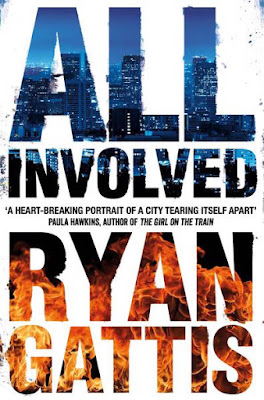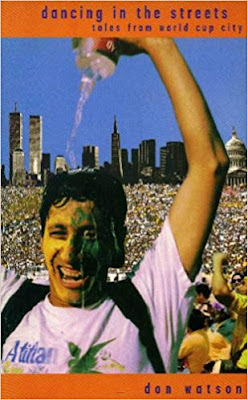Ryan Gattis - All Involved
London: Picador, 2015
Why is this book on the bedroom floor? - I first came across a review of this in Nick Hornby’s Stuff I’ve Been
Reading, a collection of reviews for The New Yorker. It sounded interesting and
I filed it away at the back of my mind, until coming across it in a Blue Cross
shop about a year ago.
About the Author - Ryan Gattis is a
novelist who lives in LA and is part of a street-art crew. He’s written half a
dozen books. All Involved is the product of Gattis’ two and a half years of
research and interviews with eyewitnesses to the 1992 LA riots.
Plot - Set over six days of the infamous
LA riots of 1992, the book loosely charts the fall-out from a revenge killing
on the brother of a member of Big Fate’s crew, drawing in family, deadly
rivals, bystanders and the emergency services.
Review - Imagine you’re sitting there,
one evening (say, May Day or something), watching television. Then, without
knowing why, your nice suburban street or the view from your flat sits in the
epicentre of a huge urban conflagration. Shops you use daily are set ablaze and
looted, people you know by sight are mugged, beaten or even murdered. You have
nothing to do with it, by the way - you just have to sit there, watching and
waiting and hoping that you said nothing out of turn, that somebody knows you
enough to stand in your defence, or that it all blows itself out before the war
rages beyond your threshold.
Absurdly, I have experienced those fears
on a miniscule scale. Back in 2011, inspired by a very ugly riot in Tottenham, the
UK saw numerous mini-riots in smaller cities and towns, in places as unlikely
as Lincoln and Salisbury. What began as an expression of dissatisfaction with
the police was taken up by opportunists who had no connection to the incident
itself, but the civil disobedience lasted for several days at least. I recall
walking home from work through the town centre, the most direct route to where
I was living at the time, at about half past four in the afternoon. It was
completely dead, shops shut early and a couple of riot vans conspicuously
parked. A gang of kids, no more than fifteen or so, sat on benches opposite the
McDonalds’. Whether they’d done anything or if, indeed, anything had been done
at all, I wasn’t sure, but like most people I scurried on my way, keen to keep
my head down.
These riots, such as they were, blew
themselves out after a few nights, and a somewhat disproportionate response
followed. The draconian sentences meted out to what in other circumstances
might have been shoplifting or criminal damage were indicative of the need for
civil society to assert its control, because the riots grew seemingly out of
nowhere: there had been confrontations with the police before, or protest
marches which had turned violent, but not since similar events thirty years
earlier had so many streets been lost to fire and fight.
Whereas the events in Handsworth,
Bristol, Liverpool and other sites were widely regarded to have their roots in
race-related discrimination, the explanation for the 2011 riots is less clear-cut.
There seemed to be no real groundswell building at a national level for
animosity against the police, and still less a co-ordinated call for action.
This left people with the very real and very disturbing possibility that
rioters were getting involved for no reason other than they could. Boredom,
fun, greed, adrenalin, call it what you will, but this was a populous in action
which broke the unstated social contract. Not to overstate the case, but it
showed for a night or two just how thin that blue line could get.
You could term it a very British riot,
in which at best we placed the blame on kids and at worst claimed they’d been
whipped up by the usual bogeymen. Like most nasty surprises, we tend to pretend
it happens elsewhere but not here, but by ignoring it we invite a repeat. It’s
to be hoped that lessons have been learnt, and that doesn’t only go for our
suburban town centres, but also for Los Angeles, the location for Ryan Gattis’
novel All Involved.
Infamously, the city went up in flames
shortly after the acquittal of LAPD officers accused of beating Rodney King
(who had been pulled over for a traffic violation). The incident had been
caught on camera and the footage is indeed brutal, the policemen raining down
heavy blows with truncheons and kicking out at King’s bunched-up body. Part of
the issue was that the trial had been moved to a suburban courthouse in a
largely white part of the city, where the jury selection would be dominated by
those with an ethnicity expected to be sympathetic to the officers.
LA had seen race-related riots before,
most notably the Watts riots of the late 60s, but the 1992 riots were arguably
the first technicolour ones, backed by wall-to-wall news footage and
soundtracked by MTV. This was civil rights redux - just over twenty years after
the assassination of Dr. Martin Luther King and things didn’t seemed to have
changed, judging by the punishment of this other King. The case would have
repercussions beyond ‘92, but the expressions of rage which consumed inner-city
communities like Lynwood are recreated in the combustible pages of All
Involved.
Piecemeal in structure, All Involved is
a world away from the Hollywood sign, and moves with the rapidity of a film
roll dragged through a projector at too uncomfortable a speed. Its pages feel
hot and vital, desperate to finish before order is restored.
The novel is hung loosely on the
indiscriminate killing of Ernesto, a fast-food vendor. Tragically, Ernesto is
not involved at all, to use the slang for somebody outside of gang membership.
The first character affected is Payasa, Ernesto’s kid sister, who runs with a
Mexican gang headed by Big Fate. Family honour dictates she take revenge
for the killing, which in itself is a retaliation for her little brother’s
drug-fuelled rampage outside a nightclub. A short amount of detective work
leads her to the culprit, setting in motion the consequences to come. Gattis
hammers the point home that the wider trouble in the city allows for re-order -
while the police are elsewhere, cultural justice is king.
In fact, that is a principal gap in the
narrative: not one policeman gives testimony in amongst the dozen or so
reflections of the riots. We hear from Gloria, a nurse and Anthony, a
firefighter (whose sweet romance is a nice reminder that underneath this, lives
are still being lived), but cops exist only as roadblocks, ATVs, people who are
just in the edge of the frame. Late in the book, a contribution from a man
‘attached to an agency’ brings a shocking jolt of brutality into the lawless
suburbs, somehow more sickening than the shootings and Molotov cocktails. It’s
Gattis reminding us that law and order, in these circumstances, is not merely
swift but also swiftly mandated - it needs to be substantive to cut the heads
off and to discourage others to swell the throng. Or is it merely society’s own
revenge while the gates of civility are busted wide?
There is a loose structure to the order
of events, and the characters overlap, tangenitally in some cases. Most members
of Fate’s gang, Fate included, tell their tale. Because of the first person
viewpoint, we can see who has thoughts beyond their actions: the big cheese
who’s informing; the warrior who wants to protect Payasa but can’t voice it;
the second-in-command who is almost out but knows he’ll probably die. These are
the meat of All Involved, and the smaller voices we hear, like the Korean kid
helping his family protect their business, the teenaged graffiti artist and the
Vietnam vet who speaks to the city itself, these are the extra ingredients, the
spice and the oil which keeps it all from getting unpalatable. This is not the
story of LA, or even of its riots, but one collection of tales from a place we
pass through, at a strange and brief time. In that sense, All Involved is like Raymond
Carver’s city: choppy, vivid and unenviable.
All Involved is a rather extraordinary
piece of writing, and Ryan Gattis has a firm grasp of what drives Los Angeles.
By focussing on a section of its inhabitants and their lives, rather than
describing the city as a whole, he offers the riots in microcosm. Close to the
end of the book, the final character describes the Los Angeles he knows, as a
city which pushes itself through another day into clearer air. The message is
this: this is LA, good or ill, and there were killings and drugs before the
riots and will be the day after they end.
The characterisations are in-depth and
handled with aplomb, Gattis managing to put across motivations and a fair bit
of family history even as the days rattle along. At times there is some
confusion as to which Hispanic sub-group the gangs belong to (Salvi, Mexican,
etc) but that doesn’t necessarily spoil things, since it’s filial loyalty which
matters. You’re left feeling that you’ve abandoned the main protagonists just
as you were becoming part of the crew.
As for the city, you can feel its heat,
smell its odours: the frying meat, the thick smoke of burning buildings, the
blueberry gum, the disinfectant of the wards. This book is what the Grand Theft
Auto series aspires to recreate, but it’s here, right between your fingertips.
It’s no love letter to this part of Los Angeles, but it’s not unsympathetic.
It’s not populated solely by psychopaths or people in fear for their lives.
There are eye-popping events but the people that do them are small parts of a
gigantic living tapestry. Not one I’m that keen to visit, admittedly, but then
I wouldn’t last a day living their lives.
Fast, hard, fierce and annoyingly good,
All Involved is a smash to the cheek, an assault on the senses. It’s like a
lost episode of The Wire or a special ER, and like all brilliant drama, it’s
brutal because it needs to be. Life can be brutal, but there can be beauty in
its breathlessness. Ryan Gattis proves it.
Will I move it from the floor to the
bookshelf? - Absolutely. I’d be happy to read it again sometime.




Comments
Post a Comment